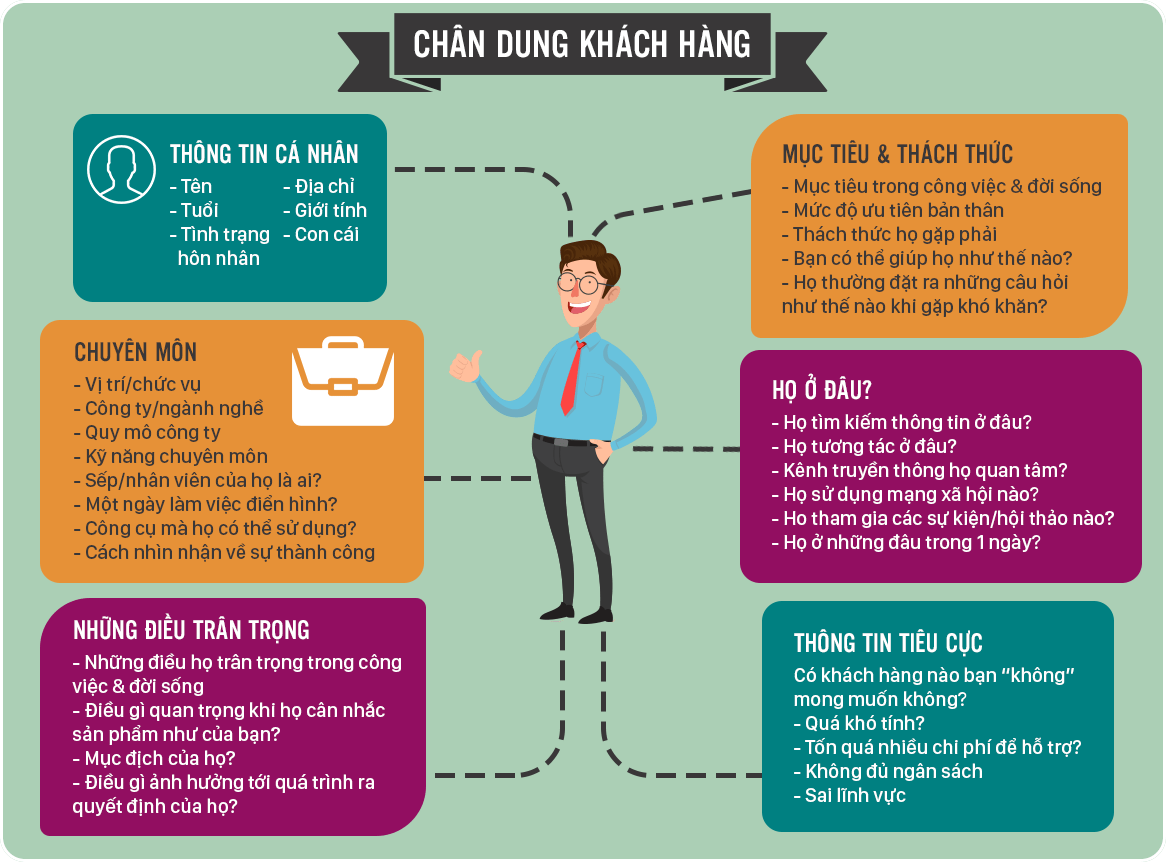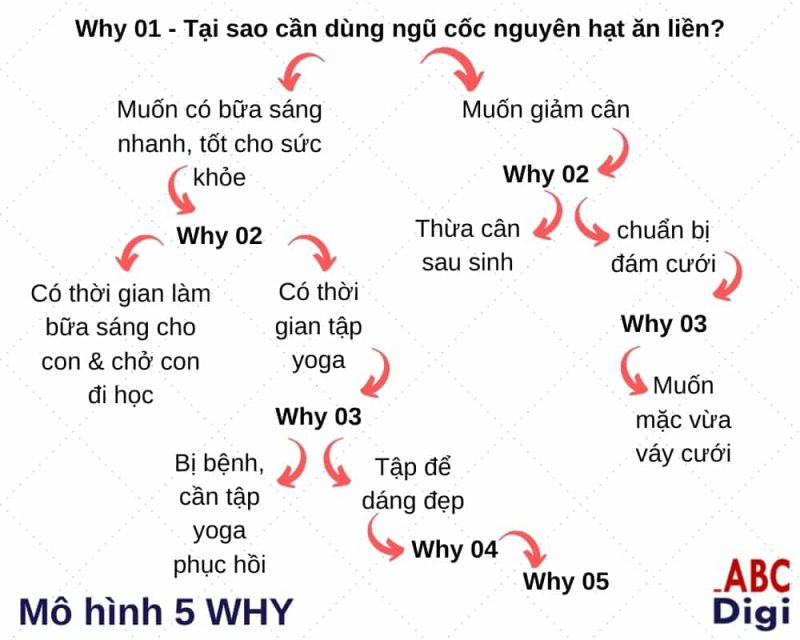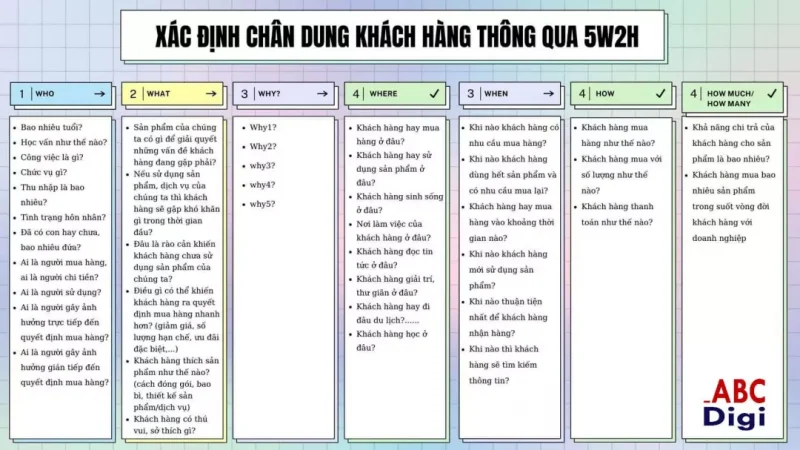
In the process of developing a business strategy, have you ever asked yourself: Who are my customers? What is your personality, what are your hobbies? How much do you understand about the customer?
If the answer is no, you should worry, because this is a very important aspect. According to a recent survey, up to 90% of large businesses have been building persona – customer portraits to understand their behavior and needs. 71% of them said that customer portraits help businesses grow revenue and achieve set business goals.
So what is persona that is so important? Are there methods that can build customer portraits closest to the target audience that the business is targeting? Let’s find out with Malu through the article below.
>>> Customer Experience: Enhancing Customer Experience
1. Persona – What is a customer portrait?
Customer Personas , Buyer Personas or Audience Personas are a hypothetical role model, representing the ideal customer portrait of a business. Persona helps businesses shape strategies for many business activities, from product development, marketing, sales to customer care.

To carry out all of the above activities, businesses are forced to thoroughly understand the behavior, needs, preferences and personalities of their target customers. Therefore, a realistic customer portrait will help the company easily visualize, go in the right direction and propose a reasonable strategy.
2. Importance of Persona – customer portrait
Persona is very important to any business. This is considered as the first step to implement important marketing and business strategies.
It will be easier to navigate the activities when you have a model to “measure shoes”, build communication messages, build, develop products and take care of customers.
In other words, knowing your target audience is not enough. What you need is to “know” their needs, interests, personalities, and behaviors.
>>> Why Do Brands Need a Customer Positioning Strategy?
2 types of customer portraits
1. Target customer portrait
This is the perfect customer of the business, who we always wish to reach. This is what we’re talking about in this article.
2. Negative Customer Persona
The buyer persona is probably the type of customer that your business is aiming for. What about the opposite, is the portrait of the guest you want to avoid, is it necessary to study? Yes, people have a whole term for it: Negative persona – the “negative” customer portrait. These are the objects that businesses should never reach, because if they have access, they will not buy.
For example:
Your business offers premium design software products for professional designers.
So amateur designers, not knowledgeable enough to use complex features, people who just want to use free software but don’t want to pay, customers with low frequency of using the software, … certainly will not be potential customers for businesses.
In addition to the target customer portrait, we should also identify the opposite portrait of the target customer to avoid approaching them in sales and marketing campaigns, saving costs, time and other resources for the business. Karma.
How is customer persona used in Marketing?
At a basic level, building customer personas helps you craft content and communications that appeal to your target audience.
In addition, customer portraits help you customize your marketing campaigns, making them more relevant to each customer segment. For example, instead of sending the same email with undifferentiated content to all customers, you can base the persona of each segment to tailor and deliver the appropriate message.
>>> What is Experiential Marketing? 10 Creative Campaigns That Can’t Be Ignored

More advanced, based on the current product lifecycle , you can also use persona to guide the next development strategy of the brand. For marketing push, product innovation, or market exit, the product life cycle and buyer persona will give you the right answer.
Even if you have time to sketch “negative” customer portraits, you can filter them into a separate group of subjects, with specific methods and care scenarios so as not to affect the results. general business.
How many customer portraits are needed?
A business can have multiple target customer profiles. As long as our products and services satisfy the needs of those customers.
For example, company A works on sales management software. A’s customers can be small shop owners, online shop owners, people specializing in selling on Facebook, people specializing in selling on e-commerce platforms, multi-channel sellers, large chain stores. With each such customer, we must create the most detailed portrait to be able to reach them most effectively.
However, almost all businesses, large or small, have limited resources (financial, human resources, …), so it is important to choose one or a few most important objects to focus on. Cardinal. Choosing this audience, also known as market segmentation , is one of the most important things to do when doing business.
In summary, customer portraits are indispensable for every business, a premise for implementing all marketing and sales activities, as well as helping to retain customers, optimize revenue and efficiency. work.
4 steps to build a Customer Portrait
The importance of Persona is something everyone can see, but is building customer personas difficult for businesses?
The answer: Reaching out to the right people, asking the right questions, at the right time will help you make sure your target customer is at your fingertips.
To collect persona from the right people, the best way is to use customer research methods – through surveys, interviews. Here are a few data collection notes to keep in mind to build customer personas:
Step 1: review historical data
For businesses that have been in business for a while, have a certain number of customers, we need to re-analyze which groups are most important to the business, for example: buying the most or bringing high profits . best.
For starters, this step can be skipped. Or you can use general industry data.
Step 2: Apply the 5W – 2H model to draw a portrait of the target customer
After having the information in step 01, we will apply the 5W – 2H model to better visualize our ideal customer . 5W – 2H are questions belonging to 7 groups: Who, Why, When, Where, What, How much/many & How . We will go into detail about the questions in these 7 groups.
1. WHO question group
These are questions to clearly define the basic characteristics, demographic characteristics of the target customer. We need to answer the following questions:
1. What gender?
2. How old are you?
3. What occupation?
4. What position?
5. Married or not?
6. Have you had children or not, how many children?
7. How much income?
8. What is your education like?
9. Who is the buyer, who is the spender? (Children buy, parents pay)
10. Who directly influences the purchase decision? (wife decides, husband buys)
11. Who is the next influence on the purchase decision? (celebrity, friends, neighbors, colleagues)
12. Who is the user? (Mother buys, I use)
2. WHAT . question group
These are questions related to the customer’s life
13. What problems are customers facing that our products can solve?
14. If using our products/services, what difficulties will customers encounter in the first time?
15. What are the barriers that prevent customers from using our products?
16. What can make customers make purchasing decisions faster? (discounts, limited quantities, special offers, etc.)
17. How do customers like the product? (packaging, packaging, product/service design)
18. What hobbies and interests do customers have?
3. WHY . question group
This is a very important group of questions, we need to dig deep to find out the main buying motivation of customers (customer insight). In this step we will apply the 5 whys method , that is, ask why 5 times continuously based on the answers of the previous whys.
19. Why 01: Why do customers need our products? -> reason 01
20. Why 02: Why does the customer need to address reason 01? -> reason 02
21. Why 03: Why does the customer need to deal with reason 02? -> reason 03
22. Why 04: why does the customer need to deal with reason 03? -> reason 04
23. Why 05: why does the customer need to address reason 04? -> reason 05

When you follow this method, you’ll find so many reasons that seem plausible, you’ll have to re-examine, or test, to see which is the most important.
4. WHERE . question group
This is a group of questions related to the space where the activities of the target customer take place.
24. Where do customers buy goods? Answering this question helps us to choose the right distribution point for goods/services.
25. Where do customers often use the product? Answering this question helps us design more relevant products. For example : a customer buys bread near the market, but only eats it when he comes to the office. So is there any way we can make the loaf stay hot and crispy during that travel time?
26. Where does the customer live?
27. Where is the client’s workplace?
28. Where do customers read news? Answering this question helps us know where to reach and provide information to customers.
29. Where are the entertainment customers?
30. Where do customers go to travel?
31. Where do customers study?
5. Question group WHEN
32. When do customers need to buy goods?
33. When do customers run out of products and want to buy them back?
34. At what time do customers buy goods?
35. When will new customers use the product?
36. When is it most convenient for customers to receive goods?
37. When will customers seek information?
6. Question group HOW
38. How do customers buy goods? (buy once, buy many times, buy by route…)
39. How do customers pay? (cash, transfer, online payment, postpaid…)
7. Question group HOW MANY / HOW MUCH
40. How many products do customers buy in 1 purchase?
41. How much are customers willing to buy, and how much are they willing to pay for a product?
42. How much are customers willing to pay for a purchase?
43. How many products do customers buy during their lifetime with the business?

Step 3: Summarize the customer persona visually
This step will help us condense the most important information of the target customer persona. From there, departments in the company will easily remember and take the correct actions.
Responses should be grouped into five groups:
- Demographics : basic information about the customer.
- Need : why they need to buy your product.
- Hobbies & Habits : preferences, daily habits of customers.
- Shopping Behavior : the shopping habits of customers.
- Barriers to Purchase : the reason why customers haven’t bought from you.
Looking at the example image below, you will know how to arrange the information properly. On the third Sheet in the Template Template has this visual description, you just need to go there and change the information accordingly.

A sample of a visualized customer portrait
Step 4: Test
Based on the newly sketched target customer portraits, you can create suitable content samples to test media campaigns. The results from these campaigns can tell you which portraits are the best fit and benefit your business.
4 actions to take after having a target customer portrait
1. Check the product/service
This check helps us to see if we need to change the product, or modify the product, add or remove benefits, adjust the price to suit the target customer.
2. Check the communication channel
Review current communication channels are suitable for target customers or not? We should limit/remove inappropriate communication channels, focus resources on channels that are suitable for customers.
>>> 19 Effective Brand Promotion Strategies
3. Check the media content
Media content that is not suitable for target customers is a mistake that many businesses make. Many businesses produce product-oriented content, which means that the product has something to say, rather than focusing on the customer’s problem.
This part is very important, you must check carefully whether the content and communication materials are suitable for the target customers or not.
>>> Brand Personality – Creating a Brand Personality
4. Check the sales scenario
Just like communication content, sales content, customer consultation scripts must also be created around the problems of target customers. The closer the content is to the customer, the higher the probability of closing the order and the value of the order can also increase.
>>> Guide to Building Professional Sales Process From AZ
Epilogue
Above are 4 steps and 43 questions to draw a target customer portrait that you can apply in an easy way. This is a very important knowledge, a fundamental knowledge of marketing in general and digital marketing in particular. If you want to go into marketing, you will have to master this knowledge.
I hope that you will practice a lot with the Template , and slowly develop the ability to quickly and sharply identify your target audience.
Important Notes:
- The target customer portrait is the perfect customer, not real. But it shows us the surrounding files, similar to this perfect portrait. These are our client files.
- A business can have multiple target customer profiles.
- The above set of questions can be flexibly added or subtracted depending on the product and business model.
- Answer the questions in as much detail as possible.
- The example in the Template Template is for reference only, many answers have not been detailed.
Good luck.




